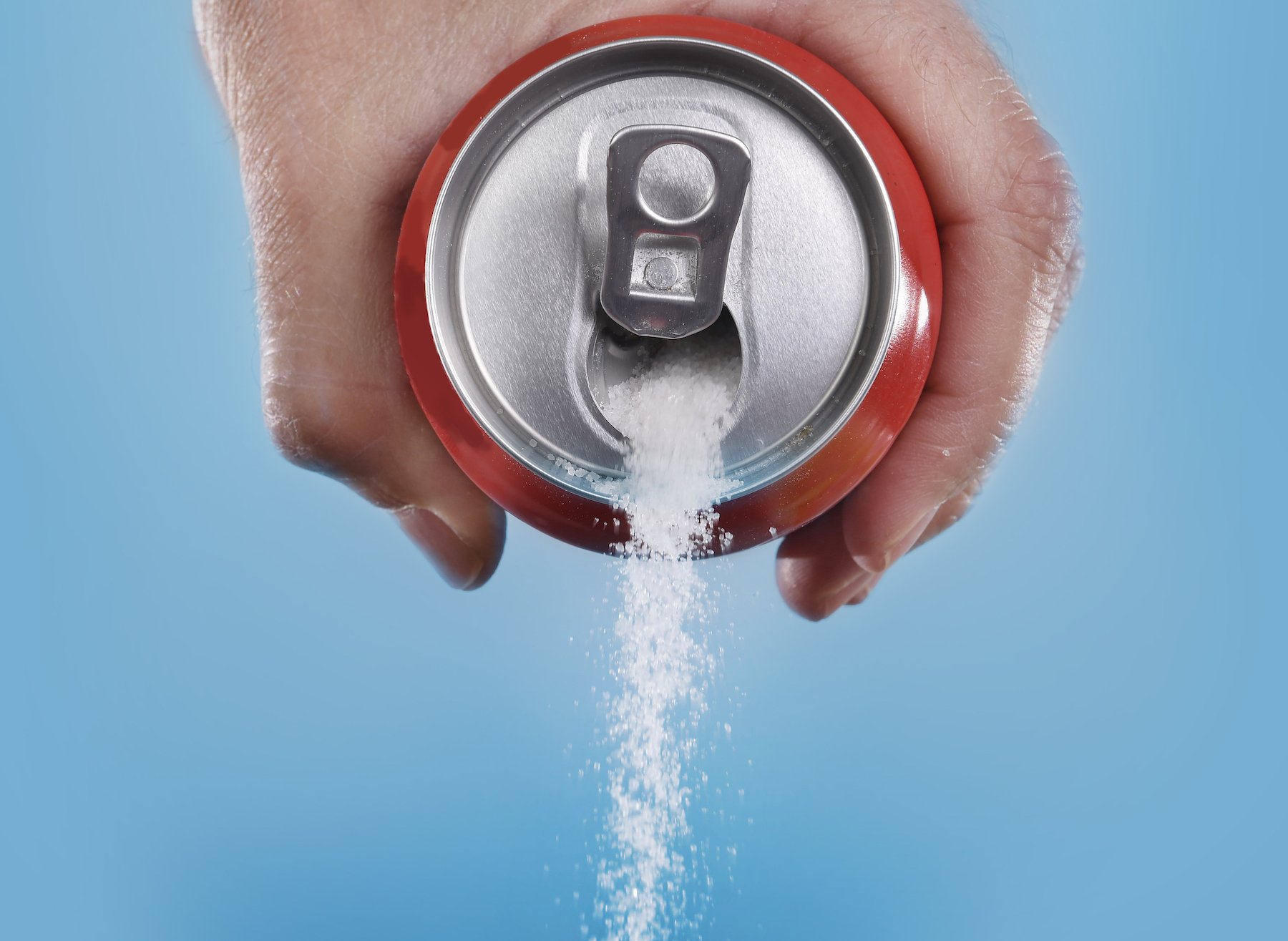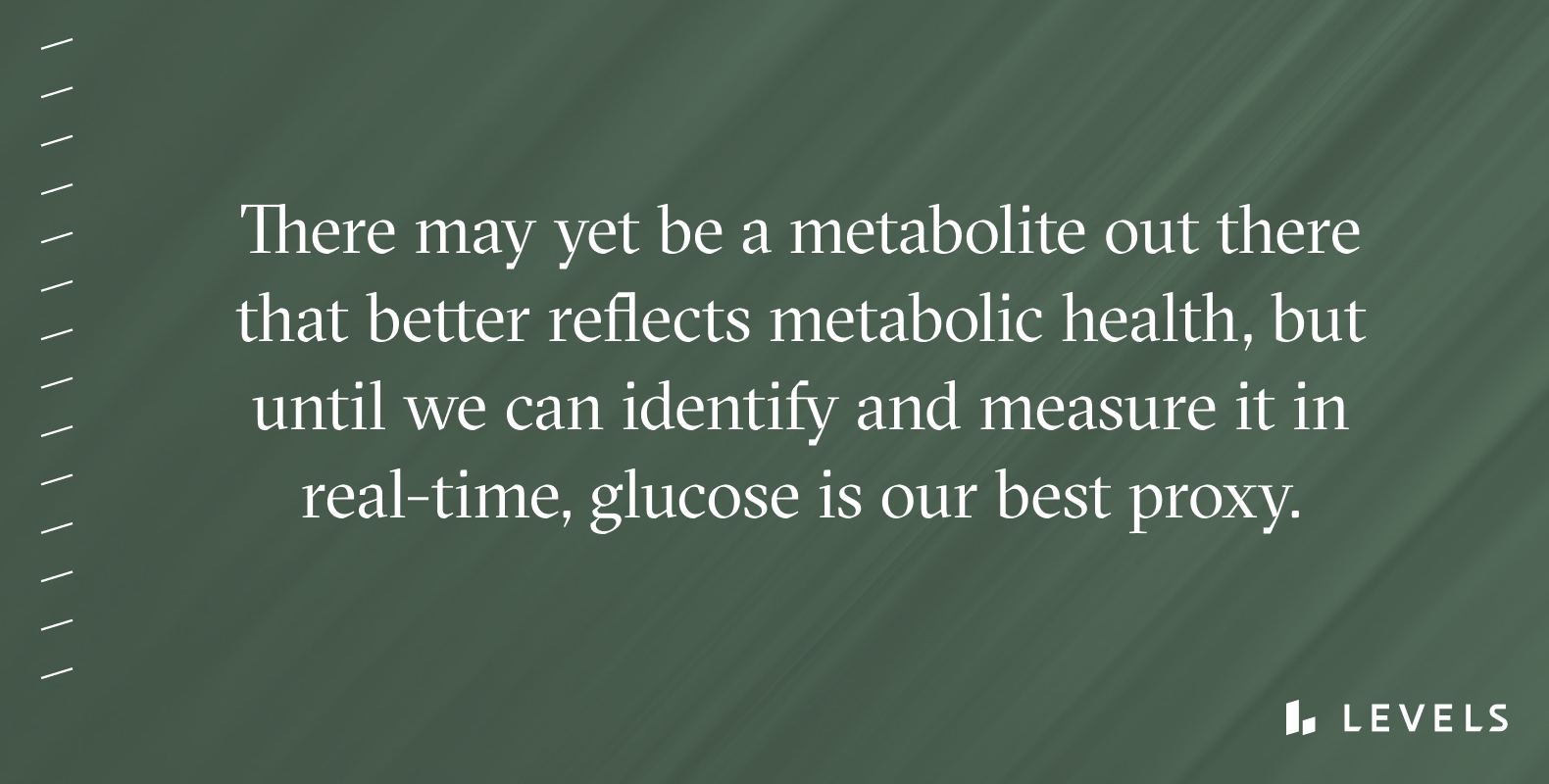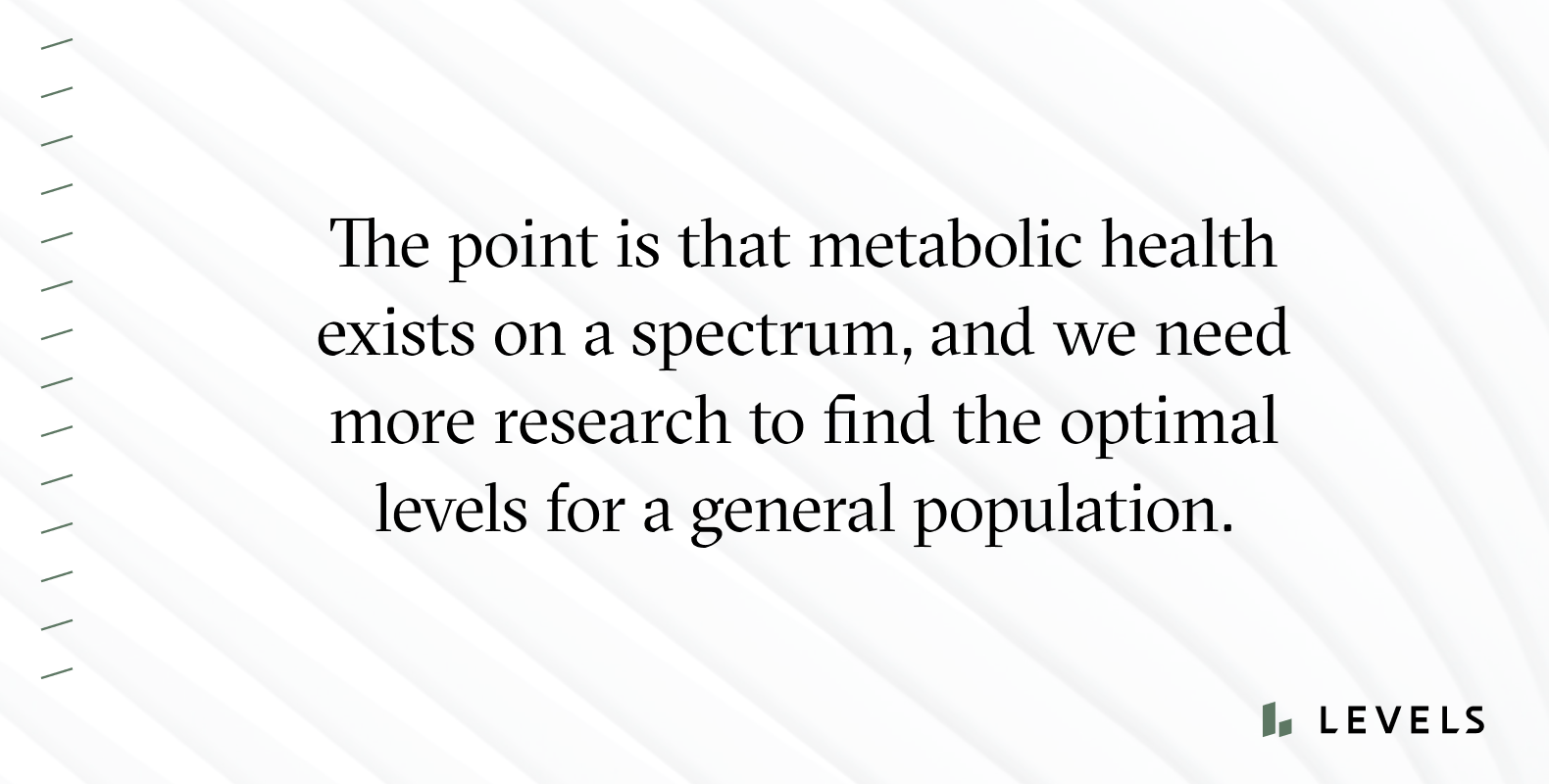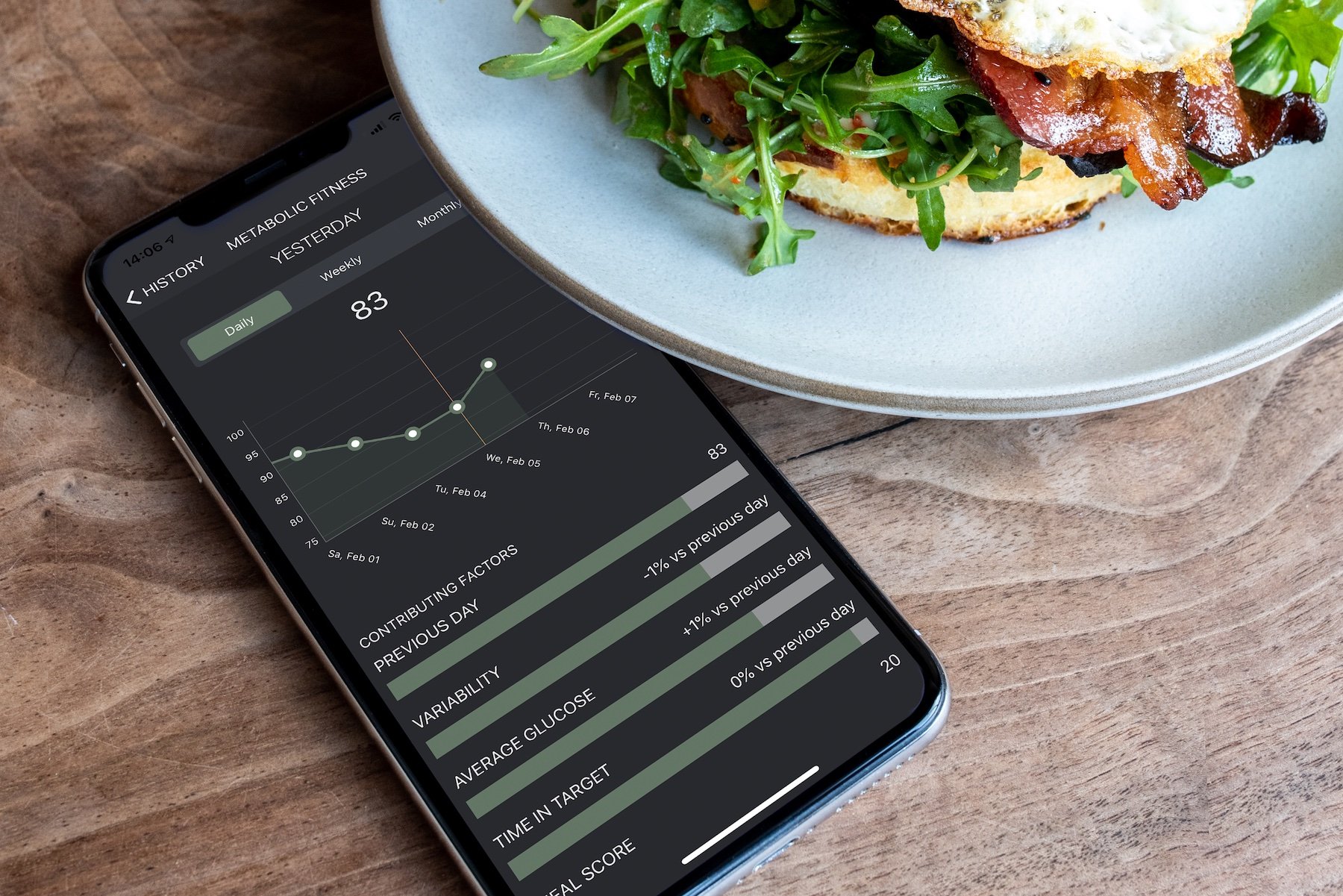This is a companion piece to the article 8 Reasons glucose is worth measuring, in which we make the case for monitoring blood sugar, even in people without diabetes. Here, we explain why—as important as glucose is—it’s not the only thing that matters.
In the discussion around metabolic health, glucose takes center stage: Monitoring it, maintaining stable levels, examining its effects on our cells and its relationship to chronic diseases like Alzheimer’s and cancer.
But the fact is: It’s a mistake to overemphasize glucose levels in the pursuit of optimal health.
Orienting nutrition and lifestyle choices solely around glucose does not guarantee long-term health. The food we eat has wide-ranging impacts on the body, driving countless biochemical processes that may have little or nothing to do with glucose and yet are critical to health and longevity.
At the same time, scientists are only just beginning to pick apart the complex ways that elements of metabolic dysfunction—including glucose dysregulation and insulin resistance—relate to one another and how these relationships might vary from person to person and develop over time. While glucose can offer us a unique moment-to-moment view of aspects of our metabolic health, it is only part of the overall picture.
“Based on our work, I think that the glucose excursion only contributes about 10% to the equation of food and health,” writes Levels advisor Dr. Robert Lustig in Metabolical: The Lure and the Lies of Processed Food, Nutrition, and Modern Medicine. “That’s not nothing, and it’s here now, so OK, sure, use it. But it doesn’t tell you about liver, pancreatic, or brain function. I actually think that postprandial insulin, c-peptide, and triglycerides will help to elaborate the other 90%.”
Here, we outline the pitfalls of fixating on a single molecule in the overall pursuit of living our healthiest lives.
1. Nutrition is About More than Glucose
Glucose control is necessary but not sufficient for optimal health.
The first pitfall is allowing glucose alone to dictate your food choices. Let’s be clear: eating for stable glucose is not the same as eating your ideal diet. It’s a component, but plenty of foods don’t cause glucose spikes but do have negative health impacts.
Foods Have Many More Consequences Beyond Glucose
Imagine, for instance, a summer meal of spicy fried shrimp with fresh greens, a scoop of ice cream drizzled with agave nectar, and an iced vodka seltzer. For many people, none of these items will spike their glucose. Does that mean we can consume them in unlimited quantities? No, because other components of these foods may have detrimental health impacts.
For starters, let’s say the shrimp are fried in canola oil. Canola oil is primarily fat and will not contribute to a glucose spike. But regularly consuming canola and other processed seed oils can wreak havoc on your metabolic health. That’s because they contain high amounts of linoleic acid.
“When linoleic acid increases, so too do its metabolic by-products,” writes Levels advisor Ben Bikman. “These by-products force fat cells to grow through a process called hypertrophy, wherein each fat cell gets bigger as it takes on more fat. Fat cells getting too big may seem like a trivial development, but it’s the key difference between the cells becoming insulin resistant or staying insulin sensitive.”
Fat cells filled with excess fat release more pro-inflammatory molecules than their trimmer counterparts, and they can leak fat into the intracellular space—two processes that can lead to insulin resistance.
On top of this, cooking with oils rich in polyunsaturated fats—including canola oil and sunflower oil—can convert them into dangerously unhealthy trans fats. For example, a 2019 study in rodents found that consuming canola oil that was previously heated to a typical frying temperature of 325°F accelerated colon cancer and increased gut inflammation.
On to dessert. For many people, glucose levels stay surprisingly steady when they eat ice cream. Several things may be at play here, including the fact that lactose, the natural sugar found in milk and cream, doesn’t spike blood sugar as refined sugars do. High-fat foods tend to slow sugar’s entry into the bloodstream, too—all of which puts ice cream’s Glycemic Index (GI) on par with raw banana and only a couple of notches higher than green peas. (This varies a lot depending on the amount of added sugar in the ice cream, of course.)
What the glucose numbers don’t reveal, however, is that even unsweetened milk products can prompt the pancreas to secrete insulin in surge quantities that are way out of proportion with their GI—by as much as 6-fold. This gives them an insulinemic index in league with white bread. While this surge may help steady post-ice-cream glucose levels, preventing short-term consequences like a blood sugar crash that leads to fatigue, long-term hyperinsulinemia is a known cause (and consequence) of insulin resistance. On top of that, several studies show that consuming dairy can impair insulin sensitivity.

What we know about dairy and blood sugar
Milk, cheese, yogurt, and other dairy products may not immediately spike your blood sugar, but they could make you more insulin resistant over time.
Read the ArticleAs for the agave nectar—its sugars are predominantly in the form of fructose, which doesn’t spike blood sugar or impact insulin secretion like glucose does. However, fructose can cause a cascade of metabolic problems when we consume too much of it.
Unlike glucose, the burden of breaking down fructose falls mainly on the liver. Ingest it faster than your liver can process it, and your liver will be forced to store fructose as fat. This can lead to non-alcoholic fatty liver disease and localized insulin resistance that can eventually disrupt your entire body’s glucose response.
Metabolizing fructose depletes ATP—the energy currency of cells—which can lead to oxidative stress and inflammation. At high rates, the reaction also produces an excess of damaging by-products, including: uric acid (which causes gout and contributes to heart disease), VLDL triglycerides (which are linked to heart disease), free fatty acids, and lactate (both of which are linked to systemic insulin resistance). Finally, fructose undergoes glycation, whereby blood sugar binds to proteins in the body, driving the aging process. Our bodies are designed to handle fructose in the small amounts found in whole fruits, but otherwise, it’s best avoided.

Why fructose is bad for metabolic health
Is fructose bad for you? Fructose is a natural sugar, but as an added sweetener, its metabolic impact can be severe.
Read the ArticleHow about alcohol? In the absence of sugar-loaded mixers, it is unlikely to spike your blood sugar. In fact, in healthy people, an alcoholic drink before a carb-heavy meal may even reduce the meal’s effect on glucose and insulin levels. Alcohol appears to dial down the liver’s production of new glucose and deliver a short-term boost in insulin sensitivity—both of which can help keep blood sugar levels stable. There is also evidence to suggest that moderate alcohol consumption (1-2 drinks per day) lowers the risk of Type 2 diabetes.

What does alcohol do to my glucose levels?
Alcohol's effect on your blood sugar has a lot to do with context: how much you're drinking, if you're fasting and the type of alcohol.
Read the ArticleBut heavy drinking can cause alcoholic liver disease—which comes with an elevated risk of insulin resistance—and damage pancreatic beta cells, hampering their ability to secrete insulin and keep glucose levels in check. Animal studies also suggest that a single session of binge drinking (defined as five drinks in a two-hour window for men; four for women) puts the body into a transient insulin-resistant state—and that women who make this a monthly habit have disproportionately high fasting blood glucose by age 43.
To be clear, a meal like this may not hurt your health in the short term, especially given the small quantity of each “offending” element. But the detrimental effects are cumulative; over time, heavy consumption of refined oils, fructose, dairy, and alcohol can all nudge your body towards metabolic dysfunction—despite their negligible impacts on moment-to-moment blood glucose readings.
Micronutrients Matter, Too
Of course, there’s more to healthy eating than avoiding certain foods. You could eat for stable blood sugar; include a thoughtful mix of macronutrients (clean proteins, carbs, and fats); limit foods that contribute to the detrimental metabolic changes outlined above—and still not be optimally nourished on a cellular level. For that, you’d need to add micronutrients: vitamins, minerals, trace metals, and antioxidants.
Micronutrients are like the essential workers who support our body’s overall health. Most perform critical functions in cellular reactions involving proteins, enzymes, and hormones, which regulate every part of our body’s functioning. We may only need them in tiny amounts, but micronutrients play an outsized role in keeping our cellular machinery running smoothly.

8 Micronutrients essential for metabolic health
Micronutrients are like tools that help our cellular machinery function better. Here's how they work, and how to ensure you're getting enough
Read the ArticleZinc, for instance, is required by more than 300 of the body’s enzymes and helps our nervous, reproductive, and immune systems function correctly. Among its metabolic impacts, zinc is essential to the proper processing, storage, secretion, and action of insulin in pancreatic beta cells. Zinc deficiency has been linked to obesity and the onset of Type 2 diabetes.
Another crucial group is omega 3 fatty acids. These are embedded in the membranes of every cell in the body, where their functions include modulating cellular signaling, protein function, and gene expression, as well as inhibiting inflammation. Evidence from animal studies suggests that by blocking changes to insulin signaling, omega 3’s can also protect against insulin resistance triggered by a high-fat diet.
Glucose readings offer us zero insight into our micronutrient levels and how they’re performing, but in the absence of these power players, the entire system may stagger and stall, leading to metabolic dysfunction.
Glucose is Only One Metabolite

The human metabolome is made up of tens of thousands of different metabolites, according to Matthew Laye, PhD, who studies exercise metabolism, physiology, and human performance at The College of Idaho. “Many metabolites respond to exercise, acute diet, stress, etcetera in the same ways that glucose does,” he says. “What makes them different from glucose is that we can’t measure them yet.” In fact, we don’t even know what they all are. There may yet be a metabolite out there that better reflects long- or short-term metabolic health, but until we can identify and measure it in real-time, glucose is our best proxy.
To truly know how the food we eat affects our bodies, we’d need to be able to measure multivariate metabolites and understand how each of them interacts with one another and with our various tissues.
Eight subcellular pathologies drive all chronic diseases, writes Lustig in Metabolical. Namely: glycation, oxidative stress, mitochondrial dysfunction, insulin resistance, cell membrane instability, inflammation, changes in gene expression, and inefficient clearing of cellular waste. These pathologies are not mutually exclusive; they interact in complex ways, and if one of them is happening in your body, likely, several others are too. Glucose impacts many of these processes, but so too do other molecules in your body.
For instance, specific molecules in food can influence how our genes behave by turning them on or off in a process called epigenetics. Nutrients including methionine, folate, choline, betaine, and vitamins B2, B6, and B12 can influence gene expression via their role as precursors to vital DNA-modulating compounds S-adenosyl-L-methionine. And preliminary studies suggest that it’s via its effect on the epigenome that vitamin B12 may confer protection against diabetes and even the adverse health effects of air pollution.
Bottom line: Glucose is not the be-all, end-all. Foods that promote short-term glucose stability don’t always support or ensure long-term health. There is nuance to optimal nutrition, and glucose is just one (albeit powerful) piece of the puzzle.
2. Glucose Measurement is Imperfect
Glucose Levels Can Mask Insulin Dysfunction
The second set of problems concerns how we interpret glucose readings. Most notably: glucose doesn’t always tell a straightforward story about insulin resistance, a core driver of metabolic dysfunction.
Research suggests that insulin dysregulation begins at least a decade before its effects are reflected in blood glucose levels. One study that followed more than 6500 middle-aged people over 19 years found that those who developed diabetes showed red flags in their insulin secretion and sensitivity levels as early as 13 years before diagnosis. This means that two people could have similar blood glucose levels but very different insulin levels, depending on where they fall on the path towards metabolic dysfunction.
Unfortunately, we’re not even looking for insulin in mainstream medical practice, writes Bikman Why We Get Sick. “We’ve been treating glucose as the main character, but it’s really the sidekick.” This is unfortunate because issues with insulin levels may be an earlier sign of metabolic dysfunction than absolute glucose values.
Your blood glucose readings could remain stable for years, even as you’re becoming insulin resistant. The body responds to the insulin resistance by producing higher and higher quantities of insulin to overcome the resistance and keep glucose levels in the “normal” range. Unfortunately, doctors don’t routinely screen for disrupted insulin processing, leaving us blind to the early markers of metabolic disease.
As much as 88 percent of the U.S. adult population is insulin resistant, but a large majority of people are entirely unaware of their metabolic health status. Insulin resistance has been identified as a contributing factor in almost all serious chronic disorders, including heart disease, diabetes, stroke, chronic liver disease, and Alzheimer’s disease.
In other words: insulin is the real culprit, and persistently abnormal glucose levels (e.g., an elevated fasting glucose level) are a downstream result of likely several years of dysfunction in insulin signaling. With that said, regular large swings in glucose after meals (called high glycemic variability) due to dietary choices can also lead to insulin resistance by overstimulating the insulin system. “Metabolic disease is not due to obesity, it’s not due to hyperglycemia—rather, it’s due to hyperinsulinemia, and we’re not treating it,” says Lustig.
We’re Not Sure Which Glucose Measures Matter Most
Another obstacle is that we don’t yet understand the nuances of how glucose levels relate to underlying health. “We’re pretty sure that lower glucose levels are better, but we don’t know what the dose-response for lower glucose looks like,” explains Laye.
Many aspects of health follow a J-shaped curve, where both low and high values put people at greater risk of complications. Exercise is a good example: in general, any amount is better than none at all. But, overtraining and too much exercise can lead to adverse outcomes. (Sleep follows a similar pattern.)
We don’t yet have a precise picture of the dose-response for lowering glucose levels. A large meta-analysis that included more than 2.6 million people found that healthy, non-diabetic people with baseline fasting glucose levels below 72 mg/dl were at increased cardiac and stroke risk compared to those with normal fasting glucose (which the authors considered between 86 mg/dL and 101 mg/dL, though we recommend aiming for 70–85 mg/dL). But we also know that consistently elevated glucose contributes to several health problems, including increased risk of prediabetes and Type 2 diabetes, increased cardiovascular risk, blood vessel damage, weight gain, and more.
Then there’s the challenge of deciphering what each different type of glucose measurement reveals about our health status—and which is most important. Should we focus on lowering our mean average glucose levels, our fasting glucose, our post-meal glucose spikes, our overall 24-hour glycemic variability—or all of the above?
A 2018 study categorized non-diabetic participants by “glucotype” according to their post-meal glycemic variability (low, moderate, or severe). It found that a subset of people who scored in the “normal” range on a battery of standard glucose tests experienced severe glucose swings that pushed them into the prediabetic range 15 percent of the time. This suggests that glycemic variability is an important early marker of insulin sensitivity that could help identify people on the path towards diabetes. Other researchers, however, argue that mean average glucose levels are as powerful for identifying high-risk individuals.
In practice, likely, the relative importance of each of these metrics—and others—in shaping long-term health will vary from person to person, says Laye. For now, we simply don’t have those detailed insights and, to date, there have been no long-term randomized controlled trials exploring whether monitoring glucose translates to better health outcomes in a general wellness population (though we have ample evidence that it improves glucose levels [as measured by HbA1c] in people with diabetes).
We Don’t Know What Optimal Glucose Looks Like
It isn’t yet clear what the optimal glucose range should be for people without diagnosed metabolic impairment. And if we don’t know what we’re aiming for—and why—how do we know if we are achieving success?
The American Diabetes Association (ADA) defines normal fasting glucose as any value less than 100 mg/dl. But research shows that people with fasting values in the high-normal range are at greater risk of health complications than others in the “normal” bracket, suggesting that we should not necessarily be content to find ourselves there.

For example, a study that looked at more than one million Korean adults found that those with a fasting glucose level of ~100 mg/dl had higher risk of coronary heart disease than those with levels ~90 mg/dl. Another study found that among 13,000 Israeli men aged 26 to 45, more than double the number of men with fasting glucose levels of 95-99 mg/dl developed diabetes than those who fell in the 82-86 mg/dl range.
Another study compared the health outcomes of people classed as prediabetic according to either ADA or World Health Organization (WHO) criteria. The WHO criteria put the fasting glucose threshold value for prediabetes a full 10 points higher than the ADA, at 110 mg/dl. The researchers calculated the lifetime risk of developing diabetes for people classed as prediabetic at age 45 and found that approximately half of those flagged by the ADA would develop the disease, compared to about two-thirds of those flagged by the WHO.
The point is that metabolic health exists on a spectrum, and we need more research to find the optimal levels for a general population. That doesn’t mean we shouldn’t look for those answers, but rather is all the more reason we should conduct that research.
Our Measuring Tools Have Limits
Finally, we must be mindful of the limitations of CGM technology and occasional instances where glucose readings could be misleading.
For instance, there are times when a glucose spike is not a cause for concern, such as after a hard, anaerobic workout. During bursts of high-intensity exercise, your muscles shift from using fat to using glucose as fuel. At the same time, they enter a state where they readily absorb glucose from the bloodstream without the need for insulin. The liver responds by converting glycogen to glucose up to eight times faster than normal, but the muscles only increase their glucose use by three- or four-fold. This results in excess circulating blood glucose in the hour or so during and following the anaerobic burst. However, these glucose rises shouldn’t cause the same concern as a post-meal rise. In fact, just two weeks of high-intensity training improves insulin sensitivity, possibly due to the acute depletion and replenishment of muscle glycogen.
There is also a slim chance that high levels of Vitamin C could cause false glucose spike readings because it can interfere with the enzyme-based sensors that current glucose-monitoring tech uses. A handful of studies in people with diabetes observed this phenomenon, but those studies all involved intravenous Vitamin C in doses much higher than most of us typically consume. Nevertheless, it’s worth keeping in mind that a technology that relies on complex biochemical reactions may be susceptible to interference from any non-standard molecules circulating in the blood.
(It’s worth noting that other glucose measures are no better windows into our overall metabolic health and may be worse. Fasting glucose and oral glucose tolerance tests—two of the most widely deployed for assessing diabetes risk—each capture just a couple of moments in time. But even if we are in the normal range on both of these tests, we could still be developing insulin resistance in the background, which we don’t “see” because we aren’t measuring insulin. The third test doctors use looks at hemoglobin A1c, which reveals an approximate three-month blood glucose average. While it has the benefit of offering a longer lens on the situation, an A1c test can’t capture glycemic variability, which may be a stronger predictor of metabolic dysfunction than hyperglycemia alone.)
Bottom line: Glucose is a limited way to screen for metabolic problems because insulin resistance may begin years before its effects show up as glucose dysregulation. Scientists are only just beginning to pick apart how different facets of glucose variability relate to long-term health, and our ideas about what is “normal” and what is “optimal” are still evolving.
What We Still Need to Know
Despite the limitations outlined here, we believe in the value of glucose monitoring to empower individuals to explore and improve their metabolic health. Today, CGM is the only tool in our arsenal for gaining insight into how our bodies respond, moment-to-moment, to our diet and lifestyle choices.
That said, here are several fundamental studies that we think would move the picture of metabolic health along substantially:
- A large-scale, longitudinal, double-blinded randomized controlled trial looking at the utility of CGM as a preventative health tool. We’re aware of only one small trial currently underway, exploring the power of CGM to support behavior change and improve metabolic health. We’d love to see a scaled-up version of this, following hundreds of thousands of people over decades and looking at how CGM affects disease risk factors such as hyperglycemia, BMI, and hypertension, as well as the eventual incidence of chronic disease.
- A large-scale, longitudinal study to identify robust new biomarkers of metabolic health. “This might give us a better, more sensitive biomarker than glucose,” explains Laye. Ideally, this study would draw on all of the “-omic” approaches, he says, integrating information from the genome, the metabolome, and the microbiome to pursue the root causes and markers of disease.
- A large-scale, longitudinal study exploring how different glucose biomarkers, including fasting glucose, mean average glucose, peak post-meal glucose, and glycemic variability, relate to one another and how each ultimately impacts healthspan and disease risk.
So Why Bother Measuring Glucose at All?
These limitations and critical areas of further research shouldn’t be surprising: We are in the early days of trying to improve metabolic health across broad populations. But they also don’t mean that it’s not worth trying to answer these questions. That we only have anecdotal data now is all the more reason we need to use the tools available to acquire more data.
Levels Advisor Dr. Robert Lustig believes measuring glucose is one of several important aspects of monitoring metabolic health when he says, “There are a lot of other analytes that are going to end up being important. Glucose is just the start, but it’s what we can measure now. I’m glad Levels is doing it.”
Dr. Sara Gottfried agrees that to begin solving the metabolic health crisis with personalized action; we need “dense continuous glucose data, which we know will more comprehensively identify the people at greatest risk, and potentially allow us to intervene before insulin resistance is more difficult to reverse.”
Metabolic health is a crisis we need to start solving at scale. At this time, glucose is the best measure we have: it’s one of the few biological markers we can easily and cheaply measure in real-time, and it’s actionable. If we see our blood sugar rising, we can go for a walk to help blunt a spike or take note to change our diet slightly next time. It’s not the whole story, but it’s worth paying attention to.








